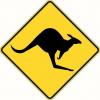
Originally Posted by
Warren Mickley

Yes, Robert, you are missing something. For a smoother a rounded edge means the cut will feather to nothing at the edge. If you just round the corners, the edge of the cut is not as abrupt as a flat edge, but still noticeable nonetheless. Rounded tracks instead of square tracks. In addition the problems with having the iron slightly tilted to one side are much more severe with an iron that has rounded corners than one which has a nice sweeping curve. If you are not planing boards that are wider than the iron, it does not matter very much.




 Reply With Quote
Reply With Quote






